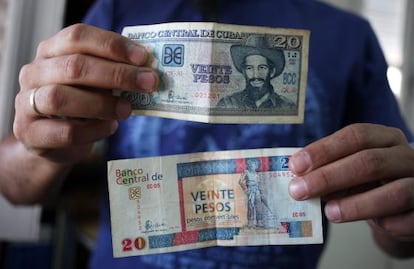Havana scraps two-tier currency system as part of its latest economic reforms
Cuban government will gradually do away with a double peso rates introduced in 1994

The Cuban government announced on Tuesday that it is to eliminate the two-tier currency system that it adopted in 1994 to help ease the economic pressures on the island.
In an announcement made in the official Communist Party newspaper Granma, the government of Raúl Castro said it was scrapping the two currency system: the convertible peso (CUC), pegged to the US dollar, and the commonly used lower-valued peso (CUP), used by islanders for basic services.
“This measure, in conjunction with other policies directed toward the updating of our model, will allow for the ordering of the economic environment and, consequently, the accurate measurement of its performance,” the government said in a note published in Granma on Tuesday.
Since 1994, Cubans have been paid salaries based on the CUP, which was worth a fraction of the CUC, and used the currency to buy products and pay for services at home. The CUC was used for exports and in the tourism sector, which has boomed since the collapse of the Soviet Union and the withdrawal of substantial aid by Moscow.
The move is part of a series of economic reforms that Castro announced back in July.
“As has been stated, monetary and currency exchange unification is not a measure which will, in itself, resolve all of the economy’s current problems, but its implementation is indispensable to reestablishing the value of the Cuban peso and its function as money; that is to say, as a unit of accounting, payment and savings,” Granma reported in its English edition.
Without giving any time frame, the newspaper said the change would take place in stages with “a period of preparation of conditions which will allow for the development of proposed legal norms, the design of changes in data processing systems used in bookkeeping and adjustments to accounting regulations.”
The difference between prices for goods and services valued in CUC in the parallel market and the state subsidies is enormous. A bottle of cooking oil in a store that accepts parallel currency costs between two and three CUC pesos (or $2 and $3), depending on the brand and size. But a family of four is allowed to spend 25 CUP pesos ($1) for a week’s shopping with its ration book. But government subsidized products are scarce and the average Cuban, who earns about 500 CUP pesos a month, or about $20, is forced to purchase products on the parallel market.
Food subsidies cost the government more than a billion dollars a year and it is no longer able to afford it because about 80 percent of food consumed on the island is imported.
The article published in Granma said that for now “stores which operate in CUC may accept payments in CUP via debit cards denominated in this currency.”
“Experimentally in selected sites, CUP payments will be accepted in cash for the equivalent, based on the current [official] exchange rate of 25 CUP to 1 CUC,” the article said.
Tu suscripción se está usando en otro dispositivo
¿Quieres añadir otro usuario a tu suscripción?
Si continúas leyendo en este dispositivo, no se podrá leer en el otro.
FlechaTu suscripción se está usando en otro dispositivo y solo puedes acceder a EL PAÍS desde un dispositivo a la vez.
Si quieres compartir tu cuenta, cambia tu suscripción a la modalidad Premium, así podrás añadir otro usuario. Cada uno accederá con su propia cuenta de email, lo que os permitirá personalizar vuestra experiencia en EL PAÍS.
¿Tienes una suscripción de empresa? Accede aquí para contratar más cuentas.
En el caso de no saber quién está usando tu cuenta, te recomendamos cambiar tu contraseña aquí.
Si decides continuar compartiendo tu cuenta, este mensaje se mostrará en tu dispositivo y en el de la otra persona que está usando tu cuenta de forma indefinida, afectando a tu experiencia de lectura. Puedes consultar aquí los términos y condiciones de la suscripción digital.
Últimas noticias
Reinhard Genzel, Nobel laureate in physics: ‘One-minute videos will never give you the truth’
Pinochet’s victims grapple with José Antonio Kast’s rise in Chile
How Japan is trying to avert ‘digital defeat’
The complicated life of Francesca Albanese: A rising figure in Italy but barred from every bank by Trump’s sanctions
Most viewed
- Pablo Escobar’s hippos: A serious environmental problem, 40 years on
- Why we lost the habit of sleeping in two segments and how that changed our sense of time
- Charles Dubouloz, mountaineering star, retires at 36 with a farewell tour inspired by Walter Bonatti
- Trump’s obsession with putting his name on everything is unprecedented in the United States
- The Florida Keys tourist paradise is besieged by immigration agents: ‘We’ve never seen anything like this’









































